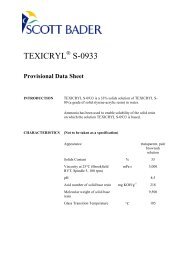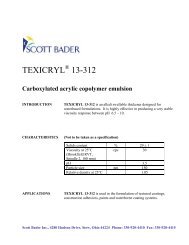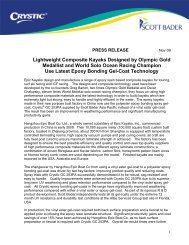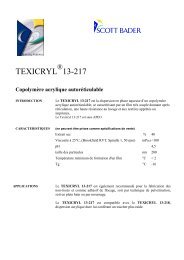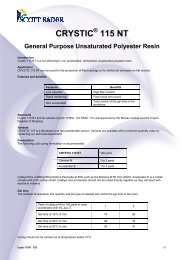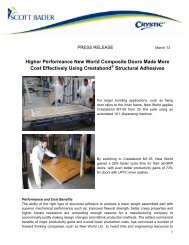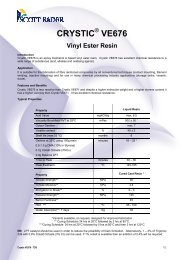Crestabond M7-15 - English - Scott Bader
Crestabond M7-15 - English - Scott Bader
Crestabond M7-15 - English - Scott Bader
Create successful ePaper yourself
Turn your PDF publications into a flip-book with our unique Google optimized e-Paper software.
CRESTABOND ® <strong>M7</strong>-<strong>15</strong><br />
Methacrylate Structural Adhesive<br />
Introduction<br />
<strong>Crestabond</strong> <strong>M7</strong>-<strong>15</strong> is a toughened, two component acrylic adhesive designed for bonding composites, thermoplastics<br />
and metals. <strong>Crestabond</strong> <strong>M7</strong>-<strong>15</strong> is a primerless adhesive, requiring only minimal surface cleaning of the substrates to be<br />
bonded.<br />
Features<br />
• Primerless metal application<br />
• High strength and modulus<br />
• Fast setting and curing<br />
• Excellent environmental resistance<br />
• Ready-to-use two component adhesive<br />
Benefits<br />
• Speeds assembly process<br />
• Replaces mechanical fasteners<br />
• Reduce labour<br />
• Bonds difficult metals and plastics<br />
Characteristics of <strong>Crestabond</strong> <strong>M7</strong>-<strong>15</strong><br />
Characteristics Typical Value<br />
Working Time (Geltime) 1 10 – 20 Minutes<br />
Fixture Time 30 – 45 Minutes<br />
Gap Filling<br />
1 – 5 mm<br />
Flash Point 10°C<br />
Mixed Colour<br />
Off White<br />
1. Working time measured with 12g mass of adhesive with 1:1 mix ratio by volume at 24°C.<br />
Physical Data – Uncured<br />
Physical Data – Cured<br />
Typical Value<br />
Property <strong>M7</strong>-<strong>15</strong> Adhesive Activator<br />
Specific Gravity 0.98 – 1.02 0.98 – 1.02<br />
Mix Ratio (by volume) 1.0 1.0<br />
Mix Ratio (by weight) 1.0 1.0<br />
Viscosity 50,000 – 70,000 cPs 30,000 – 50,000 cPs<br />
Colour Off White Off White<br />
Stability at 20°C 2 6 Months 6 Months<br />
Property Typical Value<br />
Tensile Strength 20 – 23 MPa<br />
Tensile Modulus 1400 – 1700 MPa<br />
Tensile Elongation 34 – 43%<br />
Tested to ASTM D638.<br />
2. Stability defined from date of manufacture when left un-opened in<br />
the original containers and stored between <strong>15</strong>°C and 23°C.<br />
<strong>Crestabond</strong> ® <strong>M7</strong>-<strong>15</strong> – TDS 1/3
Bond Joint Strength – Typical Lap Shear Strengths<br />
(MPa) at 23°C<br />
Values are based on substrate failure where marked by *<br />
GRP/FRP*<br />
PVC<br />
ABS<br />
Cold Rolled Steel<br />
Aluminium<br />
Galvanised<br />
Acrylic<br />
0 5 10 <strong>15</strong> 20 25<br />
Lap Shear Strength (MPa)<br />
Material Surface Preparation<br />
Bondline<br />
Thickness<br />
Test Method<br />
GRP Solvent Degrease 3.00mm ASTM 5868<br />
PVC Solvent Degrease 0.76mm ASTM 2564<br />
ABS Solvent Degrease 0.76mm ASTM 2564<br />
Cold Rolled Steel<br />
Degrease, Abrade &<br />
Degrease<br />
0.26mm ISO 4587<br />
Aluminium Solvent Degrease 0.26mm ISO 4587<br />
Galvanised Steel Solvent Degrease 0.26mm ISO 4587<br />
Acrylic Solvent Degrease 0.76mm ASTM 2564<br />
Please contact <strong>Scott</strong> <strong>Bader</strong> Technical Services for information on other substrates.<br />
Temperature Performance Lap Shear Testing<br />
Tested to ISO 4587:2003 0.26mm bondline, aluminium<br />
6061-T6, acetone wipe surface preparation.<br />
Working Time Testing<br />
The time taken for a 12g mass to reach 30°C at different<br />
ambient temperatures.<br />
Lap Shear Strength (MPa)<br />
30<br />
25<br />
20<br />
<strong>15</strong><br />
10<br />
5<br />
Working Time (Mins: Sec)<br />
38:00<br />
33:00<br />
28:00<br />
23:00<br />
18:00<br />
13:00<br />
08:00<br />
0<br />
-40 -20 0 23 40 60 80 100<br />
Temperature (°C)<br />
03:00<br />
18 20 22 24 26 28 30<br />
Temperature (°C)<br />
Recommended Substrates<br />
Metals Thermoplastics Composites<br />
Aluminium<br />
Stainless Steel<br />
Carbon Steel<br />
Powder Coated Metals<br />
Galvanised/Zinc Coated Metals<br />
Acrylic<br />
Styrenics<br />
ABS<br />
PVC/CPVC<br />
GRP/FRP<br />
Epoxy 3<br />
Polyester & DCPD Modified<br />
Vinyl Esters<br />
Urethanes<br />
Gel Coats 4<br />
Carbon Fibre<br />
3. Surface preparation of epoxy laminates may be necessary and testing should be performed to ensure sufficient bond<br />
strength is achieved.<br />
4. Surface preparation is likely to be needed on gel coat surface to ensure no release agents are present.<br />
Please contact <strong>Scott</strong> <strong>Bader</strong> Technical Services for information on other substrates and advice.<br />
Surface Preparation<br />
The surface to be bonded can affect the strength and durability of the bond joint. Appropriate treatment may be required<br />
to ensure that there are no traces of oil, grease or dirt through the use of a degreasing agent, for instance acetone or<br />
another degreasing agent on the joint surfaces.<br />
Mechanically abrading or chemically etching degreased surfaces can make bond joints more durable and stronger. If<br />
abrading, a second treatment of degreasing is required.<br />
Do not use gasoline (petrol), low grade alcohol or paint thinners.<br />
i) Metals<br />
The surface should be clean and dry by using an alcohol/solvent wipe and allowing the solvent to evaporate before<br />
application.<br />
<strong>Crestabond</strong> ® <strong>M7</strong>-<strong>15</strong> – TDS 2/3
ii) Thermoplastics<br />
The surface must be clean, dust-free and dry. A suitable solvent such as iso-propanol can be used to degrease.<br />
iii) Composites<br />
The surface must be clean, free of dust and dry. This can be achieved by the use of proprietary strippable cloths such as<br />
peel-ply (without lubricant contaminates). The laminate should be fully cured prior to bonding and if the laminate surfaces<br />
are more than 3 days old, it is recommended that the surface must be cleaned with a suitable solvent or cleaner with a<br />
lint-free, clean cloth prior to bonding.<br />
Surface preparation is likely to be needed on gel coat surfaces to ensure no release agents are present. However, when<br />
bonding epoxy laminates please test bond strength prior to application.<br />
Application<br />
Prior to bonding, ensure the substrate surface is clean by following instructions provided. Bulk dispensing equipment<br />
should be in good operating condition. Check valves on cartridges for any obstructions and remove as necessary to<br />
ensure product flows easily. Dispense the adhesive at slow rate initially onto a non-bonding surface until the bead colour<br />
is uniform. Check the dispensed bead for cure quality before beginning the bonding assembly. Dispense enough<br />
adhesive to fill the bond gap before parts are mated. Avoid dry bond by using adequate pressure to mate parts, and<br />
clamp properly to prevent joint movement.<br />
All these processes must be completed before the working time of the mixed adhesive expires. To ensure thorough cure,<br />
the adhesive must be applied at temperatures between 18°C and 26°C. The viscosities of both adhesive and activator<br />
are affected by temperature. To ensure consistent dispensing in meter-mix equipment, adhesive and activator<br />
temperatures should be held reasonably constant throughout the year.<br />
For industrial/commercial use only. Not to be used in household applications. The user must determine the suitability of a<br />
selected adhesive for a given substrate and application. Contact you local <strong>Scott</strong> <strong>Bader</strong> representative for questions or<br />
assistance with the selection of adhesives for your use. This product is intended for use by skilled individuals at their own<br />
risk. Recommendations contained herein are based on information we believe to be reliable. The properties and strength<br />
values obtained under controlled conditions at the <strong>Scott</strong> <strong>Bader</strong> laboratory.<br />
Storage<br />
The shelf life for <strong>Crestabond</strong> <strong>M7</strong>-<strong>15</strong> is 6 months from date of manufacture when stored at a recommended temperature<br />
between <strong>15</strong>°C and 23°C. Long term exposure above 23°C will reduce the shelf life of these materials. Prolonged<br />
exposure above 35°C should be avoided as the reactivity of the product is quickly diminished. The expiry date is<br />
indicated on the cartridge labels.<br />
It should be stored in its original container out of direct sunlight. The bulk product or cartridge material should be opened<br />
only immediately prior to use, and it’s highly recommended that products should never be frozen or exposed to<br />
temperatures above 35˚C during shipping or storage.<br />
Packaging<br />
<strong>Crestabond</strong> <strong>M7</strong>-<strong>15</strong> is supplied in 20 litre pails, 200 litre drums and 400ml cartridges.<br />
Health and Safety<br />
See separate Material Safety Data Sheet.<br />
Version 2 : February 2013<br />
All information on this data sheet is based on laboratory testing and is not intended for design purposes. <strong>Scott</strong> <strong>Bader</strong> makes no representations or warranties of any<br />
kind concerning this data. Due to variance of storage, handling and application of these materials, <strong>Scott</strong> <strong>Bader</strong> cannot accept liability for results obtained. The<br />
manufacture of materials is the subject of granted patents and patent applications; freedom to operate patented processes is not implied by this publication.<br />
SCOTT BADER COMPANY LIMITED<br />
Wollaston, Wellingborough, Northamptonshire, NN29 7RL<br />
Telephone: +44 (0) 1933 663100<br />
Facsimile: +44 (0) 1933 666623<br />
www.scottbader.com<br />
<strong>Crestabond</strong> ® <strong>M7</strong>-<strong>15</strong> – TDS 3/3





